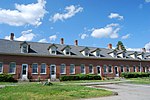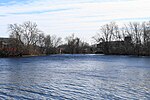Last Green Valley National Heritage Corridor
Geography of Hampden County, MassachusettsGeography of New London County, ConnecticutGeography of Tolland County, ConnecticutGeography of Windham County, ConnecticutGeography of Worcester County, Massachusetts ... and 6 more
National Heritage Areas of the United StatesTourist attractions in Hampden County, MassachusettsTourist attractions in New London County, ConnecticutTourist attractions in Tolland County, ConnecticutTourist attractions in Windham County, ConnecticutTourist attractions in Worcester County, Massachusetts
The Last Green Valley National Heritage Corridor is a federally designated National Heritage Corridor in northeastern Connecticut and portions of Massachusetts. It has a rural character with rolling hills, farmland and classic New England scenery. This area was designated because it is one of the last remaining stretches of green in the Boston to Washington, D.C. heavily urbanized corridor. The valley also has the largest stretch of dark night sky in the Northeast megalopolis corridor. It contains some of the largest unbroken forests in Southern New England, in a region of Connecticut known as the Quiet Corner.
Excerpt from the Wikipedia article Last Green Valley National Heritage Corridor (License: CC BY-SA 3.0, Authors).Last Green Valley National Heritage Corridor
Furnace Street,
Geographical coordinates (GPS) Address Nearby Places Show on map
Geographical coordinates (GPS)
| Latitude | Longitude |
|---|---|
| N 41.8 ° | E -71.883333333333 ° |
Address
Furnace Street 143
06239 , Danielson
Connecticut, United States
Open on Google Maps









